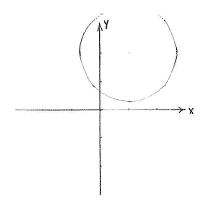Lösung 4.1:6b
Aus Online Mathematik Brückenkurs 1
(Unterschied zwischen Versionen)
K (hat „Solution 4.1:6b“ nach „Lösung 4.1:6b“ verschoben: Robot: moved page) |
|||
| Zeile 1: | Zeile 1: | ||
| - | + | Wir vergleichen unsere Gleichung mit der allgemeinen Gleichung eines Kreises, wo (''a'',''b'') der Mittelpunkt, und ''r'' der Radius ist, | |
{{Abgesetzte Formel||<math>(x-a)^2 + (y-b)^2 = r^2\,\textrm{.}</math>}} | {{Abgesetzte Formel||<math>(x-a)^2 + (y-b)^2 = r^2\,\textrm{.}</math>}} | ||
| - | In | + | In unseren Fall können wir die Gleichung wie |
{{Abgesetzte Formel||<math>(x-1)^2 + (y-2)^2 = (\sqrt{3})^2</math>}} | {{Abgesetzte Formel||<math>(x-1)^2 + (y-2)^2 = (\sqrt{3})^2</math>}} | ||
| - | + | schreiben. Also haben wir einen Kreis mit dem Mittelpunkt (1,2) und mit dem Radius <math>\sqrt{3}\,</math>. | |
[[Image:4_1_6_b.gif|center]] | [[Image:4_1_6_b.gif|center]] | ||
Version vom 18:02, 2. Apr. 2009
Wir vergleichen unsere Gleichung mit der allgemeinen Gleichung eines Kreises, wo (a,b) der Mittelpunkt, und r der Radius ist,
| \displaystyle (x-a)^2 + (y-b)^2 = r^2\,\textrm{.} |
In unseren Fall können wir die Gleichung wie
| \displaystyle (x-1)^2 + (y-2)^2 = (\sqrt{3})^2 |
schreiben. Also haben wir einen Kreis mit dem Mittelpunkt (1,2) und mit dem Radius \displaystyle \sqrt{3}\,.

